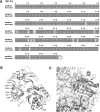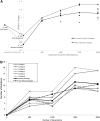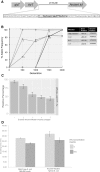Experimental Evolution of Escherichia coli Harboring an Ancient Translation Protein
- PMID: 28233029
- PMCID: PMC5371648
- DOI: 10.1007/s00239-017-9781-0
Experimental Evolution of Escherichia coli Harboring an Ancient Translation Protein
Abstract
The ability to design synthetic genes and engineer biological systems at the genome scale opens new means by which to characterize phenotypic states and the responses of biological systems to perturbations. One emerging method involves inserting artificial genes into bacterial genomes and examining how the genome and its new genes adapt to each other. Here we report the development and implementation of a modified approach to this method, in which phylogenetically inferred genes are inserted into a microbial genome, and laboratory evolution is then used to examine the adaptive potential of the resulting hybrid genome. Specifically, we engineered an approximately 700-million-year-old inferred ancestral variant of tufB, an essential gene encoding elongation factor Tu, and inserted it in a modern Escherichia coli genome in place of the native tufB gene. While the ancient homolog was not lethal to the cell, it did cause a twofold decrease in organismal fitness, mainly due to reduced protein dosage. We subsequently evolved replicate hybrid bacterial populations for 2000 generations in the laboratory and examined the adaptive response via fitness assays, whole genome sequencing, proteomics, and biochemical assays. Hybrid lineages exhibit a general adaptive strategy in which the fitness cost of the ancient gene was ameliorated in part by upregulation of protein production. Our results suggest that an ancient-modern recombinant method may pave the way for the synthesis of organisms that exhibit ancient phenotypes, and that laboratory evolution of these organisms may prove useful in elucidating insights into historical adaptive processes.
Figures




Similar articles
-
Fitness benefits of a synonymous substitution in an ancient EF-Tu gene depend on the genetic background.J Bacteriol. 2024 Feb 22;206(2):e0032923. doi: 10.1128/jb.00329-23. Epub 2024 Jan 30. J Bacteriol. 2024. PMID: 38289064 Free PMC article.
-
Functional Constraints on Replacing an Essential Gene with Its Ancient and Modern Homologs.mBio. 2017 Aug 29;8(4):e01276-17. doi: 10.1128/mBio.01276-17. mBio. 2017. PMID: 28851849 Free PMC article.
-
Control of the tRNA-tufB operon in Escherichia coli. 2. Mechanisms of the feedback inhibition of tufB expression studied in vivo and in vitro.Eur J Biochem. 1988 Aug 1;175(2):363-74. doi: 10.1111/j.1432-1033.1988.tb14205.x. Eur J Biochem. 1988. PMID: 2456927
-
Control of the tRNA-tufB operon in Escherichia coli. 1. rRNA gene dosage effects and growth-rate-dependent regulation.Eur J Biochem. 1988 Aug 1;175(2):355-62. doi: 10.1111/j.1432-1033.1988.tb14204.x. Eur J Biochem. 1988. PMID: 2456926
-
Elongation factor Tu: a molecular switch in protein biosynthesis.Mol Microbiol. 1992 Mar;6(6):683-8. doi: 10.1111/j.1365-2958.1992.tb01516.x. Mol Microbiol. 1992. PMID: 1573997 Review.
Cited by
-
Fitness benefits of a synonymous substitution in an ancient EF-Tu gene depend on the genetic background.J Bacteriol. 2024 Feb 22;206(2):e0032923. doi: 10.1128/jb.00329-23. Epub 2024 Jan 30. J Bacteriol. 2024. PMID: 38289064 Free PMC article.
-
Experimental Design, Population Dynamics, and Diversity in Microbial Experimental Evolution.Microbiol Mol Biol Rev. 2018 Jul 25;82(3):e00008-18. doi: 10.1128/MMBR.00008-18. Print 2018 Sep. Microbiol Mol Biol Rev. 2018. PMID: 30045954 Free PMC article. Review.
-
Functional Constraints on Replacing an Essential Gene with Its Ancient and Modern Homologs.mBio. 2017 Aug 29;8(4):e01276-17. doi: 10.1128/mBio.01276-17. mBio. 2017. PMID: 28851849 Free PMC article.
-
Corrigendum: Ancestral Sequence Reconstructions of MotB Are Proton-Motile and Require MotA for Motility.Front Microbiol. 2021 Mar 19;12:650373. doi: 10.3389/fmicb.2021.650373. eCollection 2021. Front Microbiol. 2021. PMID: 33815339 Free PMC article.
-
Exoplanet Biosignatures: Future Directions.Astrobiology. 2018 Jun;18(6):779-824. doi: 10.1089/ast.2017.1738. Astrobiology. 2018. PMID: 29938538 Free PMC article. Review.
References
MeSH terms
Substances
LinkOut - more resources
Full Text Sources
Other Literature Sources

